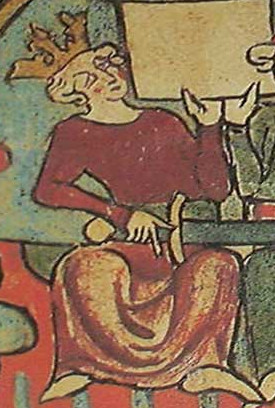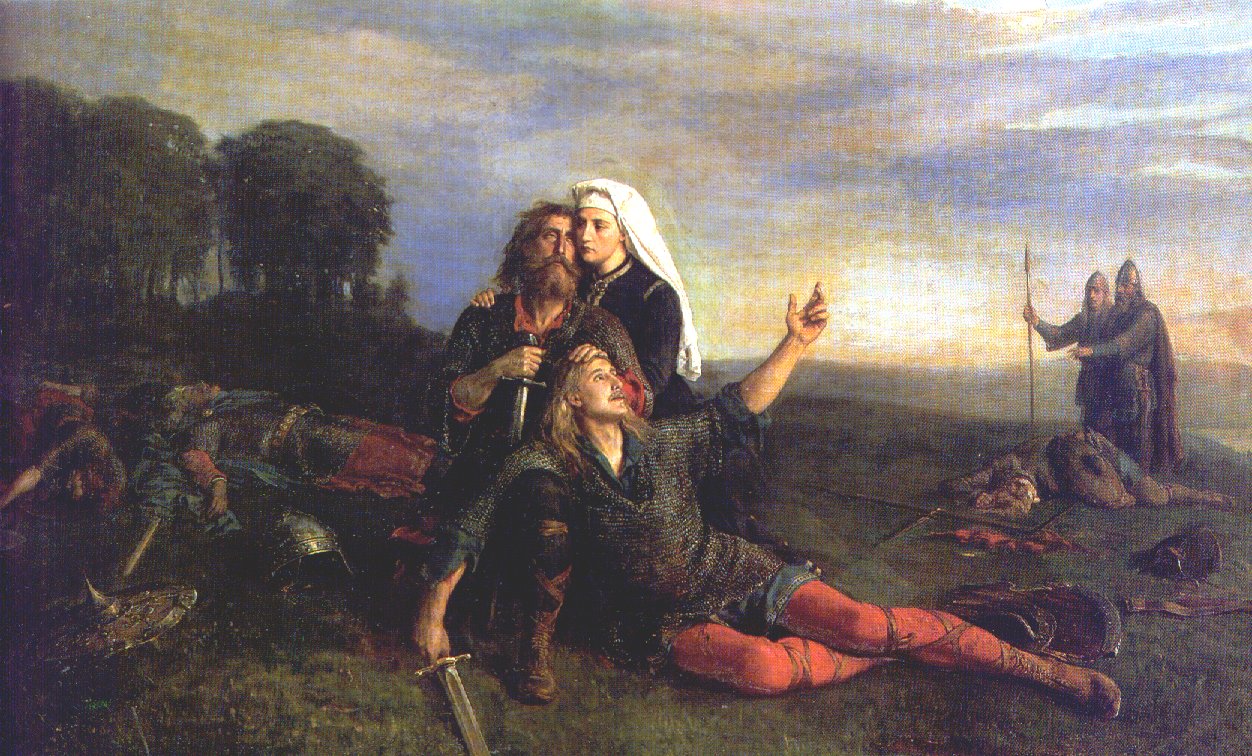|
Samsons Saga Fagra
''Samsons saga fagra'' (The Saga of Samson the Fair) is an Old Norse chivalric saga. Summary Philip Lavender has summarised the saga as follows:We are introduced to Samson, son of King Artús, who falls in love with Valentína, a princess, while she is kept as a hostage at his father's court. The saga is divided into two parts, the first of which takes place mostly in the British Isles and describes the vicissitudes of Samson's search for the lost Valentína—harassed by the rogue Kvintalín—and eventual reunion with her. The second focuses on Sigurðr, an illegitimate son of King Goðmundr of Glæsisvellir, who after being adopted by a humble couple makes his way in the world and ends up conquering and acquiring many lands through three successive marriages. This second part is linked to the first as Samson sends the chastened Kvintalín to steal a magic cloak from Sigurðr at the end of his life. Kvintalín succeeds and kills the now aged Sigurðr in the process, only to be ... [...More Info...] [...Related Items...] OR: [Wikipedia] [Google] [Baidu] |
Chivalric Sagas
The ''riddarasögur'' (literally 'sagas of knights', also known in English as 'chivalric sagas', 'romance-sagas', 'knights' sagas', 'sagas of chivalry') are Norse prose sagas of the romance genre. Starting in the thirteenth century with Norse translations of French '' chansons de geste'' and Latin romances and histories, the genre expanded in Iceland to indigenous creations in a similar style. While the ''riddarasögur'' were widely read in Iceland for many centuries they have traditionally been regarded as popular literature inferior in artistic quality to the Icelanders' sagas and other indigenous genres. Receiving little attention from scholars of Old Norse literature, many remain untranslated. The production of chivalric sagas in Scandinavia was focused on Norway in the thirteenth century and then Iceland in the fourteenth. Vernacular Danish and Swedish romances came to prominence rather later and were generally in verse; the most famous of these are the Eufemiavisorna, them ... [...More Info...] [...Related Items...] OR: [Wikipedia] [Google] [Baidu] |
Legendary Saga
A legendary saga or ''fornaldarsaga'' (literally, "story/history of the ancient era") is a Norse saga that, unlike the Icelanders' sagas, takes place before the settlement of Iceland.The article ''Fornaldarsagor'' in ''Nationalencyklopedin'' (1991) There are some exceptions, such as '' Yngvars saga víðförla'', which takes place in the 11th century. The sagas were probably all written in Iceland, from about the middle of the 13th century to about 1400, although it is possible that some may be of a later date,Einar Ól. Sveinsson, "Fornaldarsögur", in ''Kulturhistorisk leksikon for nordisk middelalder fra vikingtid til reformasjonstid, bd. 4'' (Copenhagen, 1959) such as ''Hrólfs saga kraka''. Description of the sagas In terms of form, ''fornaldarsögur'' are similar to various other saga-genres, but tend towards fairly linear, episodic narratives. Like sagas in other genres, many quote verse, but in the ''fornaldarsögur'' that verse is almost invariably in the metre of Eddaic v ... [...More Info...] [...Related Items...] OR: [Wikipedia] [Google] [Baidu] |
Möttuls Saga
''Möttuls saga'' or ''Skikkju saga'' (The saga of the cloak) is an Old Norse translation of ''Le lai du cort mantel'' (also known as ''Le mantel mautaillié''), a French fabliau dating to the beginning of the 13th century. The saga tells the story of a chastity-testing cloak brought to the court of King Arthur. It was translated, along with other chivalric sagas, under the patronage of Haakon IV of Norway. Its risqué content suggests that it was translated by clerks rather than in a religious context. ''Möttuls saga'' formed the basis for a later set of Icelandic rímur In Icelandic literature, a ''ríma'' (, literally "a rhyme", pl. ''rímur'', ) is an epic poem written in any of the so-called ''rímnahættir'' (, "rímur meters"). They are rhymed, they alliterate and consist of two to four lines per stanza. T ... called ''Skikkjurímur''. Complete texts of the saga date from the 17th century. However, there are indications that ''Möttuls saga'' may have been one of the ear ... [...More Info...] [...Related Items...] OR: [Wikipedia] [Google] [Baidu] |
Beowulf
''Beowulf'' (; ang, Bēowulf ) is an Old English epic poem in the tradition of Germanic heroic legend consisting of 3,182 alliterative lines. It is one of the most important and most often translated works of Old English literature. The date of composition is a matter of contention among scholars; the only certain dating is for the manuscript, which was produced between 975 and 1025. Scholars call the anonymous author the "''Beowulf'' poet". The story is set in pagan Scandinavia in the 6th century. Beowulf, a hero of the Geats, comes to the aid of Hrothgar, the king of the Danes, whose mead hall in Heorot has been under attack by the monster Grendel. After Beowulf slays him, Grendel's mother attacks the hall and is then defeated. Victorious, Beowulf goes home to Geatland and becomes king of the Geats. Fifty years later, Beowulf defeats a dragon, but is mortally wounded in the battle. After his death, his attendants cremate his body and erect a tower on a headland in ... [...More Info...] [...Related Items...] OR: [Wikipedia] [Google] [Baidu] |
Grettis Saga
''Grettis saga Ásmundarsonar'' (modern , reconstructed ), also known as ''Grettla'', ''Grettir's Saga'' or ''The Saga of Grettir the Strong'', is one of the Icelanders' sagas. It details the life of Grettir Ásmundarson, a bellicose Icelandic outlaw. Overview Grettir's saga is considered one of the Sagas of Icelanders (Íslendingasögur), which were written down in the thirteenth and fourteenth centuries and record stories of events that supposedly took place between the ninth and the eleventh centuries in Iceland. The manuscript of Grettir's saga was written down some time just before 1400 AD, making it a late addition to the tradition.. Introduction. ''The Saga of Grettir the Strong'', p. ix The author is unknown but it is believed that his story may have been based on a previous account of Grettir's life written by Sturla Þórðarson. Whoever the author was, the author shows an awareness of the Sagas of Icelanders tradition by making references to other sagas and borrowi ... [...More Info...] [...Related Items...] OR: [Wikipedia] [Google] [Baidu] |
Iceland
Iceland ( is, Ísland; ) is a Nordic island country in the North Atlantic Ocean and in the Arctic Ocean. Iceland is the most sparsely populated country in Europe. Iceland's capital and largest city is Reykjavík, which (along with its surrounding areas) is home to over 65% of the population. Iceland is the biggest part of the Mid-Atlantic Ridge that rises above sea level, and its central volcanic plateau is erupting almost constantly. The interior consists of a plateau characterised by sand and lava fields, mountains, and glaciers, and many glacial rivers flow to the sea through the lowlands. Iceland is warmed by the Gulf Stream and has a temperate climate, despite a high latitude just outside the Arctic Circle. Its high latitude and marine influence keep summers chilly, and most of its islands have a polar climate. According to the ancient manuscript , the settlement of Iceland began in 874 AD when the Norwegian chieftain Ingólfr Arnarson became the first p ... [...More Info...] [...Related Items...] OR: [Wikipedia] [Google] [Baidu] |
Sagas
is a series of science fantasy role-playing video games by Square Enix. The series originated on the Game Boy in 1989 as the creation of Akitoshi Kawazu at Square. It has since continued across multiple platforms, from the Super NES to the PlayStation 2. The series is notable for its emphasis on open world exploration, non-linear branching plots, and occasionally unconventional gameplay. This distinguishes the games from most of Square's other franchises. Development The ''SaGa'' series was created by game designer Akitoshi Kawazu, whose contributions prior to the franchise's introduction include ''Final Fantasy'' and ''Final Fantasy II''. At a time when Nintendo's Game Boy was becoming popular worldwide due to the puzzle game ''Tetris'', then-Square president Masashi Miyamoto requested that a development team create a game for the handheld console. Kawazu and fellow designer Koichi Ishii suggested that the company develop a role-playing video game, thus making ''Makai Tou ... [...More Info...] [...Related Items...] OR: [Wikipedia] [Google] [Baidu] |


